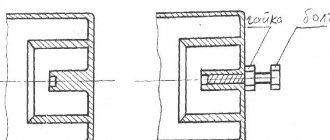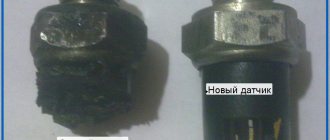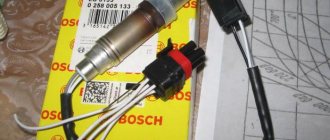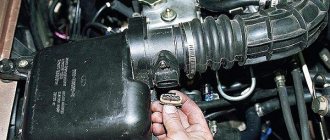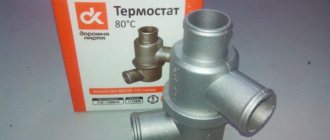The thermostat is an important element in the engine cooling system. It is responsible for warming up the engine during startup, as well as maintaining the temperature within normal limits. Replacing the VAZ 2114 thermostat is required if problems arise with long engine warm-up or boiling.
This video clearly demonstrates the process of replacing the thermostat on a VAZ 2114:
Let's figure out how to identify the malfunction of this part, how to change the thermostat with your own hands and what we need in the process of repairing the car.
Signs of a thermostat failure
In the cooling system, liquid circulates in a small and large circle. During startup, the liquid flows through a small circuit, which prevents it from cooling. At an injection engine temperature of 87 degrees, the thermostat opens and releases antifreeze through the full circuit. When it rises to 102 degrees, the element releases liquid through the radiator, which cools it even more.
When the operation of the mechanism is disrupted, the valve fails and jams in only one position, respectively, the motor either cannot heat up to the required temperature or overheats.
SIGNS OF PROBLEM
The fact that the thermostat is not working becomes clear from the rising coolant temperature.
If the engine suddenly starts to boil, you cannot turn it off. It is necessary to run the antifreeze through the “stove” for better cooling and leave the engine running at idle speed. This will allow you to slightly reduce the temperature of the antifreeze after some time.
It is also bad when the valve does not close. The engine is not warmed up, consumes more fuel, and does not develop full power. Some sources recommend checking the serviceability of the device by touch. When the valve is closed, the lower part of the body should be colder than the upper part, and when open it will be hot.
This method cannot be considered ideal, since when the antifreeze temperature is more than 1000C, the thermostat body warms up completely and will be hot to the touch. If the antifreeze is boiling, but its level is normal and there are no leaks, the thermostat needs to be replaced.
How to check the thermostat on a VAZ 2114?
There are several methods for diagnosing a thermostat:
- We start the engine and let it run for 5-10 minutes. Then we open the hood and touch the upper and lower pipes going to the radiator. If they have approximately the same temperature, then the part is working properly. When one of the pipes is cold, the part is faulty.
- We start the engine and hold on to the upper pipe. When operating properly, the hose will remain cold until the temperature reaches 87-90 degrees, at which point it will begin to heat up.
- You can remove the thermostat and immerse it in a container of water. Then they begin to heat the water, controlling its temperature. When the water heats up to a temperature of 85-90 degrees, the valve should open.
Purpose, design and principle of operation of the thermostat
The coolant circulating through the working channels of the engine blocks, its main purpose is to remove excess heat accumulated in the power unit due to the friction of the working elements of the engine and the impact of the high temperature of the exhaust gases passing through the exhaust circuit.
The main elements of the cooling system of the VAZ 2114, which are responsible for lowering the temperature of the antifreeze, are the electric cooling radiator fan and the thermostat.
To understand the principle of its operation, you need to see what the thermostat on a VAZ 2114 looks like. Structurally, it is designed in such a way that the valve that regulates the coolant flow is located inside a housing with three pipes:
- two inputs - from the engine and radiator;
- one day off - to the pump.
The main working element of the valve itself, located inside the thermostat, is a solid heat-sensitive filler, which, when heated, through a rubber insert, acts on the piston that moves the main valve. When it heats up, it opens it, when it cools down, on the contrary, it closes the hole, preventing the flow of antifreeze.
We recommend: Removing the radiator grill on Renault Duster: two methods + video
The thermostat is attached to the engine through a pipe to the cylinder head on the left side, under the air filter. It is connected to the radiator and pump using rubber pipes. On a cold engine, the valve of this coolant flow regulator is closed and after starting, the liquid that begins to be pumped by the pump forces moves along a “small circuit” or “in a small circle.” Both of these expressions are used among motorists. When moving in a small circle, the antifreeze passes through the heater radiator, intake manifold and throttle assembly. Liquid is not supplied to the radiator; the valve cuts off this path.
As the engine heats up, the coolant takes away some of the heat, heats up and, passing in a “small circle” through the thermostat, heats the temperature-sensitive element. The piston begins to move and open the main valve. This begins to happen when the liquid temperature reaches 87 degrees. In this case, part of the coolant begins to circulate through the radiator. When the temperature reaches 102 degrees, the valve opens completely, moving eight millimeters. In this mode, the entire coolant flow rushes in a “large circle” through the cooling radiator.
Experts recommend checking the operation of the thermostat without removing it from the car. To do this, after starting the engine, you need to touch the lower pipes coming from the radiator with your hands. They should be cold until the temperature rises above eighty degrees. As soon as the temperature rises above 85 degrees, the tubes should begin to heat up and after a while you can feel that the “large circle” circulation is working. The tubes should get quite hot.
If the lower pipes leaving the radiator continue to remain cold, it means the main valve has not opened and the thermostat is faulty. A malfunction of this regulator may also be indicated by the fact that the lower tubes begin to heat up almost immediately after starting the engine. This indicates that the valve is open and does not close when cold.
In both cases, a thermostat failure does not bring anything good for the engine. In the case when the valve is open, the antifreeze, passing in a “large circle,” does not have the opportunity to heat up to working condition. This reduces engine power and other performance parameters. In the case when the main valve is closed, the engine has a high risk of overheating the blocks. This is the most dangerous condition for the power unit. If you drive in this mode for some, even not very long, time, you can damage the engine, even to the point of breaking the shafts. And this, at a minimum, is a major overhaul of the entire internal combustion engine.
We recommend: How to change the brake drum on a VAZ 2107
There is a different way to check the thermostat on a VAZ 2114. To do this, you need to pour water into a pan and, placing it on the stove to heat, immerse the thermostat there. Knowing at what temperature the thermostat on the VAZ 2114 opens, use a thermometer to monitor the heating of the water in the pan. At about 87 degrees the valve should open. If this happens, then the device is fully operational. It is better to check it in this way before installing it in place of a failed one.
Many car enthusiasts often ask specialists whether it is possible to repair the thermostat.
There is only one fairly reliable way to help the valve work. To do this, lightly hit the device body with a screwdriver several times. The impact should open the valve.
If this does not happen, then the thermostat on the VAZ 2114 needs to be replaced.
Which thermostat should you choose?
First of all, you should look at the material from which the spare part is made. A common cause of failure is corrosion. Chinese manufacturers make products from cheap materials that only superficially resemble stainless steel. It is impossible to check the device upon purchase, so try to rely on reviews from other car enthusiasts.
Many people prefer to install their own VAZ thermostat, the price of which is about 1000 rubles; they last quite a long time and last about 100,000 km. You can also consider purchasing the following manufacturers:
- WEEN – 450 rubles;
- GATES – 550 rubles;
- VERNET – 650 rubles.
They have proven themselves to be one of the high-quality analogue models on the market. It is not worth saving on a thermostat, as this can lead to overheating of the motor, which will subsequently require a complete overhaul of the engine.
Useful : How to remove an air lock?
Replacement process
When moving on to the replacement process, make sure that you have prepared everything you need. It is better to replace the thermostat on a VAZ 2114 according to the following points:
- We remove the air filter housing to gain good access to the location of the element.
- Disconnect the expansion barrel and drain all the liquid from it. It would be best to drain the antifreeze into a clean container, which will allow you to reuse it, of course, if it is in good condition.
- Loosen the cooling system hoses and remove them.
- Remove the old thermostat. If dismantling is difficult, you can rock it a little.
- We clean the old sealant from the installation site, then apply a new one. Then we install a new gasket.
Check without dismantling
In fact, you need to remove the thermostat in a situation where it is definitely faulty and requires replacement.
Trying to repair this unit is almost pointless. It’s easier to buy a new one, probably working, suitable specifically for your car.
Checking without dismantling is very simple:
- First start the engine at idle;
- let it work for about 2 minutes;
- move to the engine compartment;
- feel the hose that goes from the radiator to the thermostat;
- until the sensor operates, this pipe will be cold;
- after the engine has warmed up to operating temperature, the thermostat should work;
- After this, the pipe will begin to heat up.
It is worth looking at the operating manual in advance to find out the exact temperature of the sensor response specifically on your car. The indicators are different for different machines.
If, after warming up, the large circulation pipe remains cold, the valve did not work, the device is jammed. There is also a problem if the hose begins to heat up immediately after starting.
At the same time, check the newly purchased unit. To do this, you can do without a professional tool and a remote thermometer. But you need a temperature meter designed for the heating temperature of the internal combustion engine.
The essence of the test is extremely simple. You need to take cold water into a container and completely immerse the part in it. Then begin gradual heating. Make sure that when the water reaches the thermostat response temperature, the element operates and the valve changes its position. If this does not happen, the part must be returned to the seller.
It is extremely important to choose a thermostat with a response temperature that is specified by the characteristics of your engine.
The cooling system element in question may fail for various reasons. These are factory defects, natural wear and tear, existing problems in the cooling system, incorrectly selected or old antifreeze, and much more.
Have you ever encountered similar problems? How easy or difficult was it to fix them yourself? Share your stories and opinions.
Subscribe, leave comments, tell your friends about us and ask us questions!
( 6 ratings, average: 4.83 out of 5)
Installing a thermostat from Grants for VAZ 2114
At low temperatures, the original thermostat cannot always cope with warming up the interior. The cooling system of front-wheel drive versions of cars was not modernized for a long time, and they started working on it after the production of the Samara generation. In such cases, installing a Granta thermostat helps, but how? If we look at the connection diagram for the heater radiator in a VAZ 2114, we can see that in a small circle no coolant passes through it. This means that while the engine is warming up, the car interior does not heat up until the element switches to full circuit operation. When installing a thermostat from Granta, we connect the heater radiator in series, not in parallel, and the interior will begin to receive heat evenly as the engine heats up. In addition, heat removal from the motor increases, which reduces the risk of boiling. You can learn more about the process of installing a thermostat in this video:
Don’t worry when you are faced with the question of how to replace the thermostat on a VAZ 2114 (8 valves). In this case, you can repair the car yourself, without contacting specialized services. Maintenance takes place in a couple of hours and without much labor, excluding draining the liquid, since the process is not the cleanest. When choosing a replacement part, purchase an original spare part if you have doubts about analog brands. And don’t save money, since the cooling system is an important part in the operation of a car engine. When it fails, there is a chance of the engine overheating, and the saved 300-400 rubles can turn into a major engine overhaul costing 10,000 rubles and more.
What is it and how does it work
As you understand, the thermostat is a component of the cooling system of a car engine.
In short, the task of this element is to open and close the path for the movement of fluid that flows through a small or large circle.
The operation of the device is based on a physical phenomenon. Namely, on the expansion of the liquid when it is heated. The thermostat has a rather simple device, although in fact it is a sensor and an actuator in one bottle. It consists of a cylinder which is filled with a waxy liquid, powdered copper, aluminum and graphite. There is also a rod located inside the cylinder and a pair of spring-loaded valves. One valve is for the main (large) one, and the second is for the small circle of circulation of the cooling liquid.
During operation, this element is constantly exposed to the liquid that washes it. Heat is transferred to the contents of the cylinder.
When heating occurs, the wax in the cylinder expands, the rod is squeezed out along with the valve, marking the small circle. Thus, the small circulation circle is blocked, and the liquid begins to pass through the engine radiator, and not just through the stove radiator.


